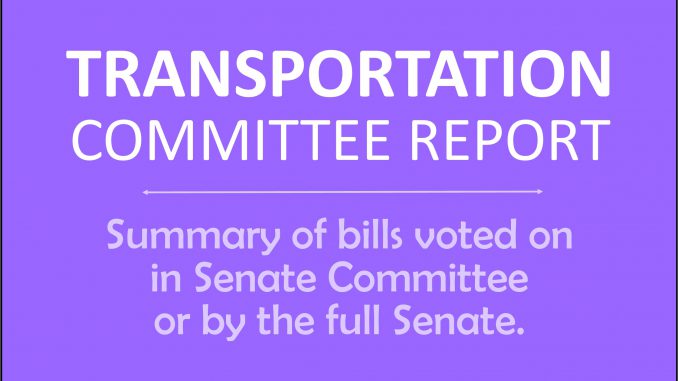
On this page
COMMITTEE ACTION:
SF 46 – Hands-free mode while driving
SF 46 requires electronic communication to only be in hands-free mode. The bill clarifies that a person can only use the device during a complete stop and off the roadway. Exemptions for the hands-free requirement include: a member of a public safety agency; health care professionals en route to an emergency; a person sending or receiving safety related information, including emergency, weather or traffic alerts.
Failure to use hands-free would result in a $45 fine, and the legislation allows the court to impose increased fines and potential suspension of a driver’s license if the violation resulted in serious injury or loss of life. For serious injury, the court could impose a $500 additional fine or driver’s license suspension for 90 days, or both. If the violation causes a death, the additional fine could be $1,000 or suspension of the driver’s license for 180 days, or both.
[2/10: short form]
SF 71 – Lights on Authorized Emergency Vehicles
SF 71 authorizes the types of lights that can be equipped on emergency vehicles owned by the state or any political subdivision of the state. It authorizes emergency vehicles to be equipped with flashing headlamps, red and blue lights, flashing or solid white lights, split red and blue steady or flashing lights and light bars containing one or more rear-zone amber light or amber directional arrows. Also, an incident command vehicle may be equipped with one or more steady or flashing green lights. Towing or recovery vehicles, unless owned by the state or municipality, are prohibited from having red and blue lights or a siren. Any emergency vehicle purchased on or after July 1, 2021. is to be equipped with a master warning switch to activate all emergency lights on the vehicle.
[2/10: short form]
SF 72 – Emergency vehicles
SF 72 is a sweeping bill covering the actions of emergency vehicles. First, it adds emergency medical services and emergency management vehicles as an authorized emergency vehicle. It allows the driver of authorized emergency vehicles to drive on the shoulder or median of the highway, to disregard laws governing overtaking or passing other motorists. It allows them to proceed past a red signal or through a red light, but only after slowing to a speed deemed necessary for safe operation by the driver based on information known at the time. It also allows the driver to exceed the speed limit so long as the driver does not recklessly endanger life or property. Any driver who has completed certain training will not be liable for any consequences of injury or loss arising from the operation of an emergency vehicle in response to an emergency call unless the vehicle is operated with reckless disregard. The bill specifies that the driver of an authorizedemergency vehicle will not be liable for any injury or lossarising from the operation of the vehicle unless recklessdisregard for the safety of people or property is proven bya preponderance of the evidence. If a person brings a tortclaim against the driver of an authorized emergency vehicle, a municipality or the state for any injury or loss arising from the operation of the authorized emergency vehicle, the billrequires a court to determine on motion by any party or onits own motion, whether the person has presented sufficient,admissible evidence to support prima facie finding of recklessness before the matter proceeds to trial.
[2/10: 8-4, party line (Excused: Bisignano)]
SF 98 – Distracted driving instruction
SF 98 states that of the 30 hours student drivers are required to complete in an approved driver education course, at least four hours must include curricula on substance abuse and distracted driving, and provide awareness about sharing the road with bicycles and motorcycles.
[2/10: short form]
SF 194 – Tinted windows
SF 194 requires that all front windshields allow a minimum standard of 70% light transmittance. Side windows can go to a minimum of 35% light transmittance. If such a vehicle is stopped by a peace officer, the driver is required to lower the window to the lowest possible position prior to the officer approaching the vehicle. A violation of this provision is $20.
[2/10: short form]
SSB 1060 – Exemption from chauffeur’s license
SSB 1060 exempts all volunteer firefighters and volunteer ambulance drivers and rescue squad attendants from being considered a chauffeur.
[2/10: short form]
SSB 1091 – Reporting dates on Road Use Tax Funds
SSB 1091 changes the reporting date for cities from September 30 to December 1 each year for monies it received from the Road Use Tax Fund. It also changes from December 31 to March 1 all moneys that revert to the street construction fund.
[2/10: short form]
SSB 1137 – Renewal of CDL online
SSB 1137 is a Department of Transportation (DOT) bill. This bill will allow many commercial drivers to renew their CDL online every other renewal period. During the pandemic, the federal government announced that CDL holders could renew online unless they hold a hazmat endorsement. Current Iowa Code prohibits online renewal for CDLs, and the bill will provide greater flexibility and convenience for those renewing and reduce unnecessary in-person appointments by 28,000. This will free up appointment times for those seeking other DOT services.
[2/10: short form]
